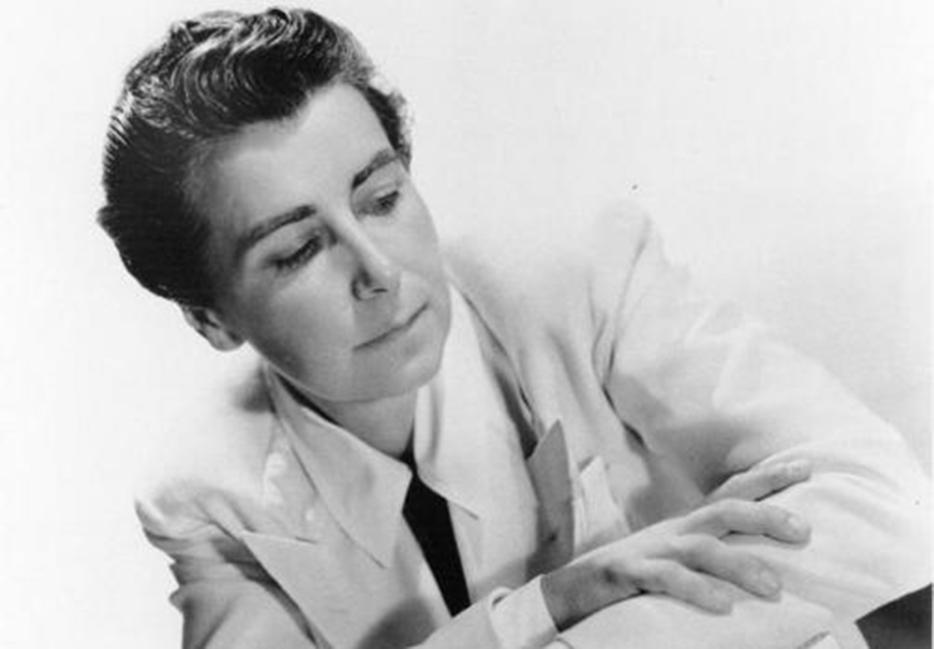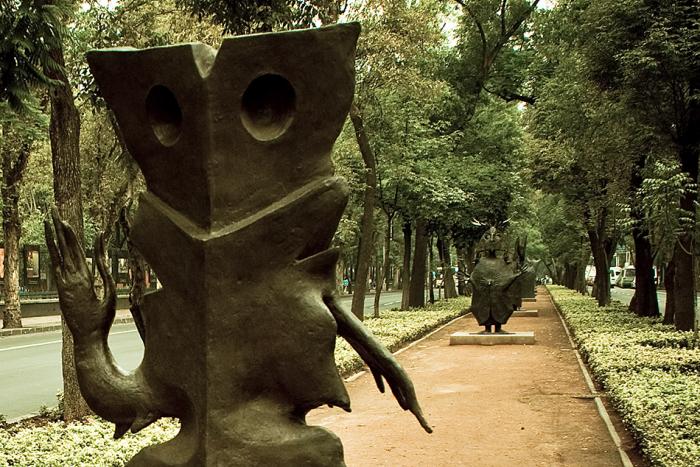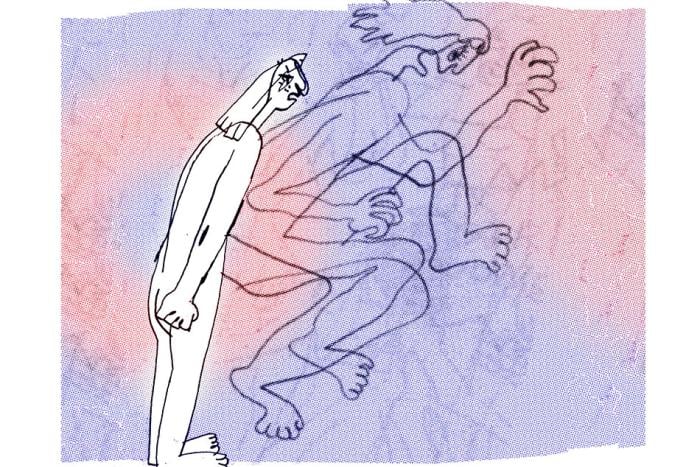Hollywood Lesbians, a collection of interviews the entertainment writer Boze Hadleigh published in 1994, now feels more antique than many of its subjects. Nearly all of them had been supporting players: sidekicks, wealthy aunts, the occasional villain. Hadleigh’s style is aggressively gossipy—a companion book about male stars claims the eighty-year-old Cary Grant made a pass at him—and he moves from empathy to insinuation with actresses like Judith Anderson and Patsy Kelly, posing them for posterity’s camera. The questioning so annoys Barbara Stanwyck that she throws him out of her house.11Clifton Webb, who wore boutonnières like Venus flytraps, is quoted calling Stanwyck “my favourite American lesbian,” a poisonous laurel, perhaps, considering how his character treated another favourite in Laura. Hadleigh’s interview with 1930s director Dorothy Arzner begins in a similar bent: “Did you play with dolls or trucks or something else as a child?”
“Just about everything except dolls,” comes the sly response. I imagined an apprentice fencer circling around their partner’s rapier.
Arzner was the only subject that Hadleigh never personally met; retired from filmmaking since the World War II drama First Comes Courage thirty years before, she had grown reclusive when her longtime partner died, seldom leaving their house in the California desert city La Quinta. But he provokes some sharply insightful comments about her place in classical Hollywood’s hierarchy: “They would avoid me for westerns or action pictures. If it was a love story, then they thought of me. The studios’ A-scripts often eluded me. I would be given an actress’s first starring assignment—not quite an A-picture in terms of prestige, but unequivocally not a B-picture. If the actress became a star, they got someone else to direct her.”
One of the star-rearing errands was 1933’s aviation melodrama Christopher Strong. Arzner shared an unfriendly respect with its young lead Katharine Hepburn, already leaning into that indomitable persona—what the critic Parker Tyler called “a jutting manner both vocal and calisthenic.” Her flying-ace character is supposed to be British, a transatlantic Earhart, though few people seem more American. Christopher Strong’s screenplay handles the story so awkwardly that they named it after her love interest, a stodgy married MP who only stays up late to work on speeches about monetary policy. Arzner sometimes has nothing to do besides panning slowly over a letter. But as these characters consummate their affair, there’s a lovely shot of Hepburn’s hand turning on the bedside lamp, cushioning the bracelet Christopher gave her with voluptuous shadow. Arzner saw the moments when domestic rituals turn pagan. Before our pilot crashes her plane in spectacularly gallant sacrifice, Hepburn gets to wear, for no real reason, a moth costume made of filmy silver.
Arzner had an acute sense of place, onscreen and in life. She once said the directors of 1930s Hollywood were no more than “hired help.” Jeanine Basinger’s book The Star Machine describes what that system was like: Even movie stars were typically employed on seven-year contracts, binding them to a particular studio, which could cast the actors in whichever project it desired—along with dictating their interviews, appearances, and conveniently public dates. If a star resisted any of that, or their 72-hour workweeks, executives could also terminate the contract at will. The five major studios all owned their own cinema chains; they required independent theatres to buy numerous films simultaneously under the practice of “block booking,” which bundled the most coveted releases together with B-movies and potential flops. Shifting financial risk onto exhibitors, the studios were able to maintain production continuously. Only the most superficial details would be provided—some of the films in each package hadn’t been shot yet.
It was an efficient system of exploitation. By the 1930s, major studios were releasing dozens of pictures a year; today they might manage half that number. Jeanine Basinger notes that MGM could complete a feature-length movie every nine days. Until 1948, when an antitrust case ended block booking, forced the majors to sell off each theater chain, and allowed the television networks to confirm their new medium’s popularity, the American film industry was a self-contained oligopoly. Dorothy Arzner spent her entire career inside that world. Her debut Fashions for Women was released in 1927, a few months before The Jazz Singer introduced sound to cinema; her last movie First Comes Courage appeared in 1943, as Hollywood struggled to groom male stars for the post-war era.22Several of these young actors could never be drafted after some gruesome injury: Van Johnson got exempted because a car accident left him with a metal plate in his head. "I went out with the big studio era,” Arzner told an oral history project decades later. “I wouldn't say that I left it. I think it left me also."
In The Work of Dorothy Arzner, the first critical study of its subject, Claire Johnston argues that classical Hollywood is both industry and ideology, a “system of representations.” Arzner is still little-known beyond scholars and film nerds four decades later, even as the discrimination that worked against her looks increasingly glaring.33Seven percent of last year’s 250 highest-grossing movies were made by women. She remains Hollywood’s most prolific female director—and what does that say about Hollywood? In the earliest days of the movies, when cinema existed as a curious novelty or avant-garde experiment, far more women found positions behind the camera, only to get pushed out as the studios evolved into standardized conglomerates. Yet the system’s inequities also granted distribution and preservation to the work of its servants. Esther Eng, another gay director, was making Chinese-language movies around the same time; today all but two are lost. “Any woman on her own is threatening or even villainous,” Arzner told Boze Hadleigh. “If she is a villain, she must be extirpated.”
*
Dorothy Arzner was born in 1897, probably—she habitually claimed 1900 as the real date, determined to be a child of the 20th century. Her family left San Francisco after the 1906 earthquake destroyed most of the city, settling in Los Angeles, where her father Louis ran a restaurant that catered to theatre types and the nascent film industry. Some of the famous regulars are now so obscure that they might as well be medieval bards, but D. W. Griffith and Charlie Chaplin also shared a table there. Arzner always denied that this environment influenced her career, and she did initially enroll in medical school at the University of Southern California. “I wanted to heal the sick and raise the dead instantly,” she recalled. “I didn't want to go through all the trouble of medicine. So that took me into the motion picture industry.”44Reversing Roland Barthes’s response to the photograph of Lewis Powell, a conspirator in the Lincoln assassination, awaiting execution: “He is dead and he is going to die.”
The Spanish flu epidemic of 1918 provided a macabre opportunity. Movie studios needed replacement staff, and Arzner got an invitation to Paramount from William De Mille, Cecil’s sibling (his director brother edited their surname so it would look better on marquees). Asked what she wanted to do in Hollywood, Arzner said that she would be happy to start “at the bottom.” De Mille snapped: “Wheredo you think the bottom is?” She ended up working as a script typist, badly. Judith Mayne’s Directed by Dorothy Arzner, the only book-length study of her work, quotes from a later profile: “There was a big, redheaded Irish girl ... who was a wonder at typing. She took pity on me and did more than half of my work. But for her I wouldn't have lasted a week.”
By some miracle, Arzner soon got promoted; she would be overseeing the continuity between script and screen for Alla Nazimova’s latest film Stronger Than Death. The Russian émigré was known to flamboyantly dominate any production she starred in; several years later she went bankrupt adapting Oscar Wilde’s Salome, an Art Deco tribute to Edwardian decadence that manages to make monochrome look extravagant. Look at the “personal life” section in any biography of a queer woman from early Hollywood, and Nazimova will reliably appear. Rumour suggests an affair, although Arzner did not love her colleague’s work habits: “I was around actors a lot, so I was not impressed by the acting off screen, as it were.” She quickly moved on anyway, turning to film editing—a job considered tedious drudgery back then, and thereby open to women. Arzner was praised for piecing together some of the earliest action scenes, cutting fluidly between Rudolph Valentino close-ups and stock footage of Madrid bullfights on Blood and Sand. She eventually threatened to quit unless Paramount recognized her skill with a chance to direct. They gave in.

By 1929, Paramount trusted Arzner enough that she got to make The Wild Party, the first talkie featuring its star actress Clara Bow. They had already collaborated on the romantic comedy Get Your Man, with Bow as a blithe American flapper who charms various French aristocrats into doing her bidding—she moved through manorial gardens like a curling tornado. (At one point the spurned love interest telegrams: "YOU HAVE KILLED MY FAITH IN WOMEN FOREVER. I'M GOING TO AFRICA TO SHOOT LIONS.") But studio executives worried about how her native Brooklyn honk would come across onscreen, and Bow kept glancing nervously at microphones mid-take, so Arzner invented a new boom mic. For her the director dutifully played straight woman. David Stenn’s Bow biography Runnin’ Wild recounts: "I told [Clara], 'Now, I don't want a lot of men around here, and I don't want any nonsense going on.' So Clara, who was really a very sweet child, would sit in her dressing room with the door wide open and say, 'See? No one in here!'"
The Wild Party belongs to a liminal moment. Bow’s character Stella is supposed to be falling in love with her anthology professor, seemingly the only person at this august women’s college not getting drunk every night, who claims he would kill for her and then says things like: “If you paid the slightest attention to my lectures, you’d know that I spent considerable time in the jungle.” Yet the film spends whole scenes relaxing with her roommates and friends, looking at men from afar. As Stella’s crew crash a party in matching lightning-bolt outfits, pacing slouches: Arzner captures the longueur that only exists between 4 a.m. and dawn, how the night distends at its end. Although The Wild Party was marketed as Clara Bow’s first talkie, she’s often shown reacting silently to something off-screen: emotions felt before and beyond language. As Arzner shot these close-ups, Bow stared into a void of drab black cloth.
During her interview with Boze Hadleigh, Arzner mentions the Motion Picture Production Code, which maintained puritanical moral standards from 1934 to the mid-1960s. Crime and adultery should never be rewarded, even with sympathy; “sex perversion or any inference to it” was forbidden. But directors hid nuance in those stories anyway, knowing the audience’s psyche would always be unregulated. Arzner argued that the Code did force female characters to the centre of the frame: In the Hollywood “women’s film,” they could live wildly, go crazy, abandon their families, even if they had to be destroyed or redeemed by the time credits rolled. Jeanine Basinger’s book A Woman’s View describes the “bliss montage” that interrupts many of these movies: “The leading lady can be seen laughing her head off, dressed in fabulous clothes, racing across the water in a speedboat, her yachtsman lover at her side … [The Bliss Montage] is a woman’s small piece of action, her marginal territory of joy.” Those borders were guarded. “At fadeout,” Arzner said, “there had to be a man and woman, newly joined or about to be, with a future full of traditional gender roles.”
The contemporary press never figured out how to explain Arzner herself: those fine white suits, the hair worn cropped beneath a beret. She was butch, but she was also short, slight, and loath to raise her voice, which confused reporters too. You see the word tomboy over and over again. I cringe even more when a reporter tries to show how “girlish” she really was, fastening onto a lace collar like some intrepid scientist. The director’s biographer quotes from a 1927 article: “Altogether you could be easily fooled into thinking Dorothy Arzner is beautiful.” Flattering to believe that a glamour was cast for your gaze alone. As a gay woman on the stages of Hollywood, Arzner could be prominent yet obscured, decisive but not free.
*
Describing the unnatural palette of his film Written on the Wind, Douglas Sirk once said: “Almost throughout the picture I used deep-focus lenses which have the effect of giving a harshness to the objects and a kind of enamelled, hard surface to the colours. I wanted this to bring out the inner violence, the energy of the characters which is all inside them and can’t break through.” When people define melodrama as a genre, they’re usually thinking of domestic-romantic films like the ones Arzner directed, even though action movies can reach the same emotional velocity. Why not call melodrama a style of ambivalence, someone trying to express what the form of the world suppresses? In her book The Desire to Desire, Mary Ann Doane argues that sentimental love stories are both “central and marginal” to the classical Hollywood cinema. Acting melodramatic is being too much.
Arzner’s eye for social theatre made her sensitive to this tension. When we first see the newspaper columnist Jerry in 1932’s Merrily We Go to Hell, he’s sitting behind a fort of empty liquor bottles, mocking the gathering from its distant edge: “Silly people.” He manages to win the attention of the canned-goods heiress Joan Prentice, and Arzner contrives a neon sign for her company behind them, like a fallen star held in glowing stasis. Joan’s father opposes the relationship, which sounds reasonable enough, since Jerry is a broke alcoholic who shows up drunk to the engagement party. Faintly resembling Ralph Fiennes, the star Fredric March plays him with easygoing detachment—a party of one. Marriage inspires him to sober up for a while, but when Jerry sells one of his plays, an old ex-girlfriend gets cast as the lead, leading to a double relapse.
Merrily We Go to Hell snuck into theatres before the Production Code was enforced, as one might guess from that title (Jerry’s toast to the death drive). Joan announces they’re opening the marriage without any euphemisms—if a modern husband can have affairs, she suggests, why not his wife?55Her main prospect is a very young Cary Grant. The trivia of living space gain a doomed significance: Jerry follows just behind his father-in-law through the foyer of the Prentice estate, then slips on his heel at the threshold. Later Joan throws him out, folding herself against the apartment door, as if a great force were coming from the other side. Jerry does finally figure out that he loves this woman, rushing home for the birth of their baby; too late he learns that Joan miscarried it, and crawls into her arms like a child. It’s melodramatic. But I would not call it comforting.
Of all Arzner’s films, Craig’s Wife rattles me most. She adapted it in 1936 from a stage play by George Kelly, the uncle of Grace, who was both a closeted gay man and an orthodox Catholic.66When he died in 1974, Kelly’s aristocratic family never invited his lover William Weagley to the funeral; he had to slip inside the chapel unannounced. The source material assumed a sternly moralistic tone, Kelly’s usual style, presenting the demon of materialism as a housewife with power. Harriet Craig dominates everyone in her life; she lies to protect her husband from a false murder charge not out of passion but the desire to protect her immaculate home. In Craig’s Wife the character becomes a tragic figure rather than a scheming villain, responding to a society that considers her independence pathological. Arzner even told George Kelly that Mr. Craig needed a mommy-domme: "I thought [he] should be down on his knees with gratitude because Mrs. Craig made a man of him." The author fumed: “That is not my play.”
That murder intrigue disappears inside the melodrama of Craig’s Wife like a knife through a soap bubble. Arzner uses blinds and windows to slit apart light: Film noir without crime. She hired interior designer William Haines, a former movie idol forced out of the industry after refusing to hide his queerness, and they redecorated the Craig home to look theatrical, marmoreal, full of ancient Greek motifs, as forbidding as a tomb. “It is evidence of people living and breathing in the house which is rendered strange,” the film historian Pam Cook wrote. “The marks of a trunk having been pulled along the floor or someone having sat on a bed acquire a sinister meaning.” When Harriet’s friends and family abandon her, the star Rosalind Russell seems to falter, paralyzed by that stately bearing, as poise recedes from her masklike face. A lone tear glistens.
No one knows exactly why Arzner stopped directing movies. She did some commercials,77Probably the only person who ended up in that field via Joan Crawford, a member of the Pepsi board. hosted a radio show, taught at UCLA (her most famous student being Francis Ford Coppola). A film with her friend Marlene Dietrich exploring “how war makes women hard and masculine” never went into production; a historical novel about early-20th-century Los Angeles remained unfinished. The only comprehensive interviews took place long after her quasi-retirement. While researching this piece, I came across a mysterious listing in the New York library system: Dorothy Arzner, photographic prints, one folder. I fantasized about looking over some film stills, maybe a cache of personal snapshots. When I opened the envelope, a pair of old publicity photos fell out.
More compelling to me is a photograph of the teenage Arzner at the beach, wearing a thick black cloak, bending away from her long hair as if casting it into the sea. When Boze Hadleigh does bring up her sexuality during that Hollywood Lesbians interview, she doesn’t sound angry, only frustrated—dismayed that a shared experience can come to feel so different. The system Arzner worked under found her existence unfathomable. On the crest of La Quinta, a valley beneath mountains, the place where she died, there’s a motto: Gem of the Desert.






